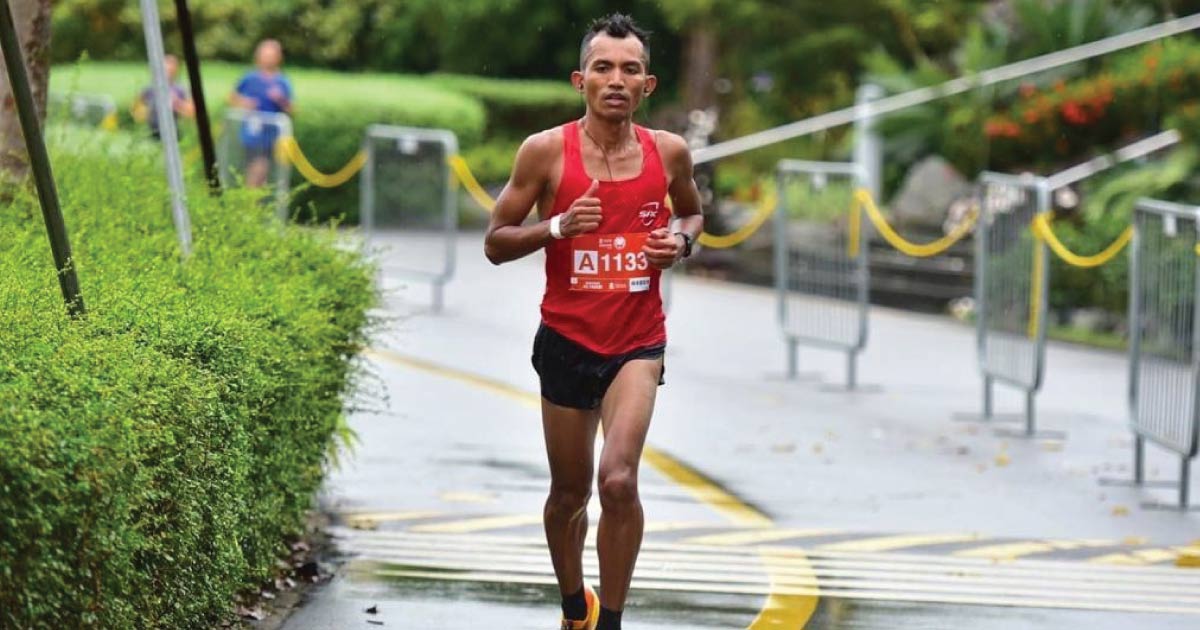

When hunting-gathering was man’s most common main occupation (which involved not only a lot of walking but also plenty of climbing and running), it was everybody’s job to be an athlete. Between that past and this present, have we run faster? Is there a physiological limit beyond which runners are unable to reach?
Engaged in the science and physiology of running is Yayasan MSU scholar Mohd Syahidan Alias a.k.a. Malaysia’s Fastest Marathoner 2016 Edan Syah. A student on the Bachelor of Education (Physical Education and Health) (Hons) programme at the Management and Science University (MSU) School of Education and Social Sciences (SESS), Edan has just bettered his own record.

Achieved at the Standard Chartered Singapore Marathon (SCSM) early this December, his 2 hours 53 minutes against the 42.2km distance (26.2 miles) means a speed of 6.6 minutes per mile.

“A race is only partly physiology, because it is also partly psychology,” says Edan. “Picture a burst of energy speeding you up just before the finish line, imagine how demoralizing this can be to others who had to slow down from exhaustion.”
Per mile, few humans, if any, could run as fast as Roger Bannister, who was the first to clock the 4-minute mile in Oxford, England on May 6, 1954. His record has to date been only slightly bettered by the Moroccan Hicham El Guerrouj, whose 3 minutes 43 seconds set in 1999 remain a mere 16 seconds improvement over Dr Bannister’s 3 minutes 59 seconds.
Over a mile, not many animals can beat humans because most animals sprint for only short distances. People have actually outrun a cheetah over long distances. Data on hunter-gatherers show their running speed averaging 10 minutes a mile against half-marathon distances. Over even longer distances, an average human has even outrun the horse.
Concludes the Head Coach to the Management and Science University (MSU) Athletics team, “A race is also more about overtaking other runners than it is about beating time. To run faster than Roger Bannister or Hicham El Guerrouj would take a lot more training and extraordinary effort, both of which, whilst probably were never really necessary in a hunting-gathering life, remain doable and achievable.”

RELATED
MSUrian champion in Langkawi 2022 Ironman 70.3
First runner-up at SCORE Marathon 2022
MSU Bachelor in Psychology (Hons)
MSU Bachelor in Outdoor, Leisure and Adventure Management (Hons)
.jpg)
When hunting-gathering was man’s most common main occupation (which involved not only a lot of walking but also plenty of climbing and running), it was everybody’s job to be an athlete. Between that past and this present, have we run faster? Is there a physiological limit beyond which runners are unable to reach?
Engaged in the science and physiology of running is Yayasan MSU scholar Mohd Syahidan Alias a.k.a. Malaysia’s Fastest Marathoner 2016 Edan Syah. A student on the Bachelor of Education (Physical Education and Health) (Hons) programme at the Management and Science University (MSU) School of Education and Social Sciences (SESS), Edan has just bettered his own record.

Achieved at the Standard Chartered Singapore Marathon (SCSM) early this December, his 2 hours 53 minutes against the 42.2km distance (26.2 miles) means a speed of 6.6 minutes per mile.

“A race is only partly physiology, because it is also partly psychology,” says Edan. “Picture a burst of energy speeding you up just before the finish line, imagine how demoralizing this can be to others who had to slow down from exhaustion.”
Per mile, few humans, if any, could run as fast as Roger Bannister, who was the first to clock the 4-minute mile in Oxford, England on May 6, 1954. His record has to date been only slightly bettered by the Moroccan Hicham El Guerrouj, whose 3 minutes 43 seconds set in 1999 remain a mere 16 seconds improvement over Dr Bannister’s 3 minutes 59 seconds.
Over a mile, not many animals can beat humans because most animals sprint for only short distances. People have actually outrun a cheetah over long distances. Data on hunter-gatherers show their running speed averaging 10 minutes a mile against half-marathon distances. Over even longer distances, an average human has even outrun the horse.
Concludes the Head Coach to the Management and Science University (MSU) Athletics team, “A race is also more about overtaking other runners than it is about beating time. To run faster than Roger Bannister or Hicham El Guerrouj would take a lot more training and extraordinary effort, both of which, whilst probably were never really necessary in a hunting-gathering life, remain doable and achievable.”

RELATED
MSUrian champion in Langkawi 2022 Ironman 70.3
First runner-up at SCORE Marathon 2022
MSU Bachelor in Psychology (Hons)
MSU Bachelor in Outdoor, Leisure and Adventure Management (Hons)
.jpg)